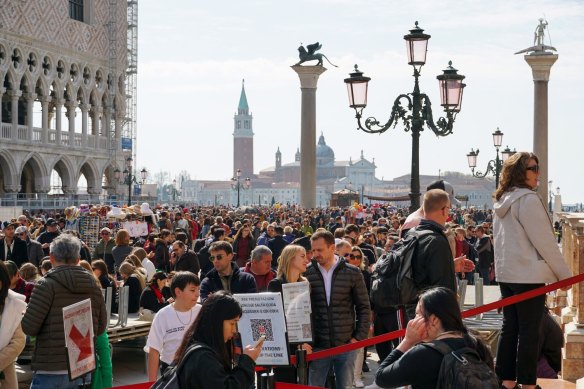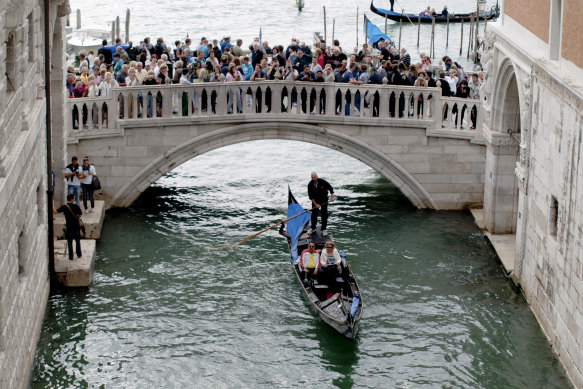By Colleen Barry
Milan: Day-trippers to the fabled canal city of Venice who fail to pay €5 to enter the lagoon city’s historic centre during a time-limited pilot program launching later this month will face fines starting at 10 times the entrance fee, officials said.
Venice announced last year it would launch the long-discussed day-tripper fee after the city escaped being placed on the UN agency’s list of endangered heritage sites, due largely to the impact of over tourism. Officials have avoided calling it a tax, opting for softer words like contribution, and have downplayed the possibility of waits to enter the city, emphasising there will be no turnstiles or physical barriers.
But during a press briefing on Thursday (Friday AEDT), Mayor Luigi Brugnaro suggested lines could form at the official entry points, and used the word tax to describe the fee.

Tourists walk along San Marco pier in Venice, Italy.Credit: Bloomberg
Brugnaro said personnel have been trained to verify that tourists who are not staying in Venice have either a QR code confirming payment of the fee or an exemption voucher. Exemptions will be issued for a variety of reasons, including to access the city for work, school or medical care, as well as to people born in Venice, and residents of the Veneto region.
Venice has long suffered under the pressure of over tourism, but officials say pre-pandemic estimates ranging from 25 million to 30 million visitors a year – including day-trippers – are not reliable and that the pilot project also aims to come up with more exact figures to help better manage the phenomenon. By contrast, registered visitors spending the night last year numbered 4.6 million, according to city figures, down 16 per cent from pre-pandemic highs.

Tourists stand in line to climb the bell tower of San Marco in Venice.Credit: Bloomberg
Visitors arriving at the main train and bus stations will first be met by stewards who will remind tourists of the new requirement and help anyone who hasn’t yet downloaded the QR code. Payment points will be set up for anyone without a smartphone.
Brugnaro said that anyone found beyond designated control points without the required documentation will be subject to fines. These will range from €50 to €300 (about $180 to $500), plus the maximum entrance fee allowed by law, set at €10.
“There is no tax without controls,” Brugnaro told foreign reporters in Rome.
Visitors will be subject to random, not systematic, checks, he said.
“If someone turns himself into Batman and tries to enter, and enters all the same, he will not win a medal from me, but we will simply thank him for his rudeness,” the mayor said.
Officials have emphasised the program aims to reduce crowds on peak days, encourage longer visits and improve the quality of life for residents. The fee is not required for anyone staying in Venice, including the mainland districts of Marghera and Mestre.
Venice’s islands, including glassmaking Murano, are also outside the 29-day pilot program, starting with an Italian national holiday on April 25 through mid-July, including most weekends, from 8.30am to 4pm. No maximum number of visitors has been set in this phase.
The city is launching an advertising campaign to inform visitors of the new obligation, featuring Brugnaro speaking a variety of languages aided by artificial intelligence. Visitors can register at the website, www.cda.ve.it, which is operating in five languages.

Traditional gondola carrying passengers pass under a bridge full of tourists near Piazza San Marco in Venice.Credit: iStock
The pandemic delayed plans to launch the day-tripper tax, which has become a keystone of the city’s attempts to deal with over tourism. UNESCO cited the plan when it decided not to include the city on the list of endangered world heritage sites last September, a tarnish that it similarly avoided two years earlier with the cruise ship ban through St Mark’s Basin and the Giudecca Canal. Cruise ships brought 1.6 million people to Venice in 2019.
Brugnaro said many cities around the globe have contacted him for details of the plan, but that they asked not to be identified.
Activists sounded a warning last summer when the number of tourist beds officially overtook the number of residents, which has dwindled to under 50,000 in a trend dating back decades. They said the imbalance drains the city of services, clogging its tight alleyways and water buses with suitcase-toting tourists and pushing residents to the mainland with its conveniences.
AP